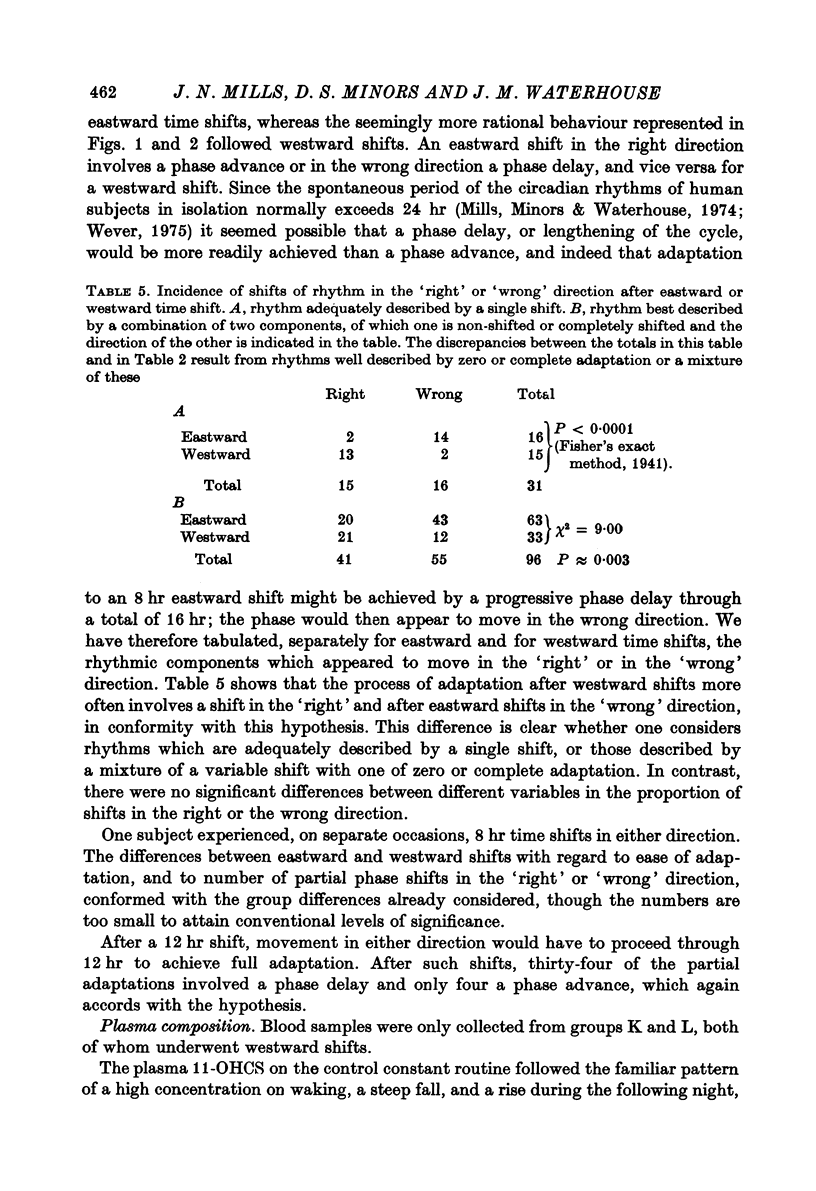Abstract
1. Thirty-six subjects in an isolation unit were subjected to time shifts of 12 hr, or of 8 hr in either direction. 2. The rhythms of body temperature and excretion of eight urinary constituents were studied before and after the shift, both on a usual nychthemeral routine and during 24 hr when they remained under constant conditions, awake, engaged in light, mainly sedentary activity, and consuming identical food and fluid every hour. 3. The rhythms on nychthemeral routine were defined by fitting cosine curves. On constant routine the rhythm after the shift was cross-correlated with the original rhythm, either with variable delay (or advance) or with an additive mixture between this variably shifted rhythm and the unshifted or a fully shifted rhythm. The process yielding the highest correlation coefficient was accepted as the best descriptor of the nature of adaptation. 4. A combination of two rhythms was observed more often for urinary sodium, chloride and phosphate than for other variables. 5. Adaptation appeared to have proceeded further after westward than eastward shifts, and this difference was particularly noticeable for urinary potassium, sodium and chloride. 6. Partial adaptation usually involved a phase delay, even after an eastward shift when a cumulative delay of 16 hr would be needed to achieve full adaptation and re-entrainment. 7. Observations under nychthemeral conditions often gave a false idea of the degree of adaptation. In particular, after an eastward shift the phase of the rhythms appeared to shift in the appropriate direction when studied under nychthemeral conditions whereas the endogenous oscillator either showed no consistent behaviour or, in the control of urate excretion, a shift in the wrong direction. 8. The implications for people undergoing time shifts, in the course of shift work or transmeridional flights, are indicated.
Full text
PDF















Selected References
These references are in PubMed. This may not be the complete list of references from this article.
- Aschoff J., Hoffmann K., Pohl H., Wever R. Re-entrainment of circadian rhythms after phase-shifts of the Zeitgeber. Chronobiologia. 1975 Jan-Mar;2(1):23–78. [PubMed] [Google Scholar]
- Elliott A. L., Mills J. N., Minors D. S., Waterhouse J. M. The effect of real and simulated time-zone shifts upon the circadian rhythms of body temperature, plasma 11-hydroxycorticosteroids, and renal excretion in human subjects. J Physiol. 1972 Feb;221(1):227–257. doi: 10.1113/jphysiol.1972.sp009750. [DOI] [PMC free article] [PubMed] [Google Scholar]
- GERRITZEN F. The diurnal rhythm in water, chloride, sodium and potassium excretion during a rapid displacement from East to West and vice versa. Aerosp Med. 1962 Jun;33:697–701. [PubMed] [Google Scholar]
- Gerritzen F., Strengers T., Esser S. Studies on the influence of fast transportation on the circadian excretion pattern of the kidney in humans. Aerosp Med. 1969 Mar;40(3):264–271. [PubMed] [Google Scholar]
- MATTINGLY D. A simple fluorimetric method for the estimation of free 11-hydroxycorticoids in human plasma. J Clin Pathol. 1962 Jul;15:374–379. doi: 10.1136/jcp.15.4.374. [DOI] [PMC free article] [PubMed] [Google Scholar]
- MILIS J. N., STANBURY S. W. A reciprocal relationship between K+ and H+ excretion in the diurnal excretory rhythm in man. Clin Sci. 1954 Feb;13(1):177–186. [PubMed] [Google Scholar]
- MILLS J. N., STANBURY S. W. Rhythmic diurnal variations in the behaviour of the human renal tubule. Acta Med Scand Suppl. 1955;307:95–96. doi: 10.1111/j.0954-6820.1955.tb16315.x. [DOI] [PubMed] [Google Scholar]
- Mills J. N. Human circadian rhythms. Physiol Rev. 1966 Jan;46(1):128–171. doi: 10.1152/physrev.1966.46.1.128. [DOI] [PubMed] [Google Scholar]
- Mills J. N., Minors D. S., Waterhouse J. M. The circadian rhythms of human subjects without timepieces or indication of the alternation of day and night. J Physiol. 1974 Aug;240(3):567–594. doi: 10.1113/jphysiol.1974.sp010623. [DOI] [PMC free article] [PubMed] [Google Scholar]
- Mills J. N., Minors D. S., Waterhouse J. M. The effect of sleep upon human circadian rhythms. Chronobiologia. 1978 Jan-Mar;5(1):14–27. [PubMed] [Google Scholar]
- Mills J. N., Minors D. S., Waterhouse J. M. The physiological rhythms of subjects living on a day of abnormal length. J Physiol. 1977 Jul;268(3):803–826. doi: 10.1113/jphysiol.1977.sp011883. [DOI] [PMC free article] [PubMed] [Google Scholar]
- Moore-Ede M. C., Schmelzer W. S., Kass D. A., Herd J. A. Internal organization of the circadian timing system in multicellular animals. Fed Proc. 1976 Oct;35(12):2333–2338. [PubMed] [Google Scholar]
- Moore-ede M. C., Schmelzer W. S., Kass D. A., Herd J. A. Cortisol-mediated synchrinization of circadian rhythm in urinary potassium excretion. Am J Physiol. 1977 Nov;233(5):R230–R238. doi: 10.1152/ajpregu.1977.233.5.R230. [DOI] [PubMed] [Google Scholar]
- Pittendrigh C., Bruce V., Kaus P. ON THE SIGNIFICANCE OF TRANSIENTS IN DAILY RHYTHMS. Proc Natl Acad Sci U S A. 1958 Sep 15;44(9):965–973. doi: 10.1073/pnas.44.9.965. [DOI] [PMC free article] [PubMed] [Google Scholar]
- SPENCER PEET J., DALY J. R., SMITH V. A SIMPLE METHOD FOR IMPROVING THE SPECIFICITY OF THE FLUORIMETRIC DETERMINATION OF ADRENAL CORTICOSTEROIDS IN HUMAN PLASMA. J Endocrinol. 1965 Feb;31:235–244. doi: 10.1677/joe.0.0310235. [DOI] [PubMed] [Google Scholar]
- Wever R. Internal phase-angle differences in human circadian rhythms: causes for changes and problems of determinations. Int J Chronobiol. 1973;1(4):371–390. [PubMed] [Google Scholar]
- Wever R. The circadian multi-oscillatory system of man. Int J Chronobiol. 1975;3(1):19–55. [PubMed] [Google Scholar]


